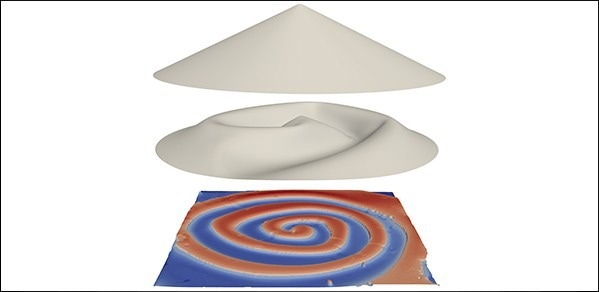Cambridge engineers studying the load-bearing capacity of soft-material conical shells have found performance-limiting flaws that can hinder the capability of morphing cones to carry out basic mechanical tasks. These findings could have ramifications for soft robotics.

Buckling of cones can produce intricate spiral ridges, as observed in both simulations (center) and experiments (bottom). Image Credit: University of Cambridge
Soft robotics uses soft elements, mechanisms, machines, and actuators—devices that transform energy into mechanical force—as building blocks to do mechanical tasks. These components are made to be malleable, squishable, and flexible. These building blocks include soft material bits that are capable of being grabbed, pulled, pushed, twisted, etc.
The strength of conical liquid crystal elastomer (LCE) shells has been determined for the first time, according to new research headed by the University of Cambridge. Lightweight shape-morphing material LCE is a good fit for soft robotics applications.
The researchers from the University of Colorado and the Department of Engineering at Cambridge examined the loading, buckling, and lifting of these thin, morphing LCE films—which can lift thousands of times their own weight—using a combination of theory, math, and experimentation. Their research was published in Physical Review Letters, and Physics Magazine published a summary of the findings.
Thin sheets of soft material are frequently used to create soft elements for use in soft robotics, allowing the material’s simple bending or stretching to drive their mechanical motions. As demonstrated by the transformation of a flat LCE sheet into a cone and its ability to lift a massive weight, the latter is strong and the former is weak.
Our work is the first to calculate and understand just how strong a thin-walled cone is. That is, of course, important for designers of soft robots that might utilize shape morphing cones as powerful actuators. However, our findings expose a weakness in the strength of these thin cones, which when compressed, deform predominantly in an outer boundary layer. This then instigates buckling at much smaller loads than what has been previously predicted.
Daniel Duffy, Study Co-Author, PhD student, Department of Engineering, University of Cambridge
He added, “More broadly, our work reveals some key underlying principles that we expect to generalize far beyond cones. We have discovered that free unclamped edges can vastly weaken thin structures in a surprising manner, and this can impact many mechanisms other than morphing cones, including structures that are not anything to do with soft robotics.”
Journal Reference
Duffy, D., et al. (2023) Lifting, Loading, and Buckling in Conical Shells. Physical Review Letters. doi:10.1103/PhysRevLett.131.148202.